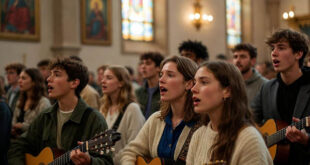“The just shall live by faith” (Romans 1:17). With these words, St. Paul reminds us that faith is not a leap into darkness but a path illuminated by reason—a divine gift that allows us to seek, understand, and love God with our whole being. But what is the relationship between faith and reason? Are they enemies, as some believe today, or inseparable allies in the pursuit of Truth?
In a world where relativism and distrust toward religion grow, the Catholic Church offers a timeless teaching: faith and reason do not oppose each other but complement one another like two wings that lift the soul toward God. This is the heart of St. John Paul II’s encyclical Fides et Ratio (Faith and Reason), a magisterial document that every Catholic should know to defend against modern errors and live a solid, intelligent, and transformative faith.
I. Faith and Reason: A Divine Alliance
Since the earliest centuries, the Church has taught that human reason, enlightened by grace, can know fundamental truths about God, man, and the world. The Church Fathers, like St. Augustine, and great theologians, like St. Thomas Aquinas, demonstrated that faith does not negate intelligence but perfects it.
God has given us two books to know Him:
- The Book of Creation (Reason): “The heavens declare the glory of God” (Psalm 19:2). Philosophy and science, properly understood, lead us to glimpse the Creator.
- The Book of Revelation (Faith): Sacred Scripture and Tradition reveal the face of Christ, the Word made flesh (John 1:14).
When man rejects one of these paths, he falls into dangerous extremes:
- Rationalism: Seeks to understand everything through reason alone, denying the supernatural.
- Fideism: Scorns reason and reduces faith to irrational sentiment.
True Catholic faith avoids both errors. As St. John Paul II said: “Faith and reason are like two wings on which the human spirit rises to the contemplation of truth” (Fides et Ratio, Prologue).
II. The Modern Crisis: When Reason Rebels Against Faith
Today, we live in an age of the “dictatorship of relativism” (Benedict XVI), where objective truth is denied. Many believe:
- “Religion is only for the unintelligent” (the myth of enlightened atheism).
- “What matters is what you feel, not what the Church teaches” (religious subjectivism).
But Catholic faith is not a fairy tale to comfort the weak. It is the answer to man’s deepest questions:
- Where do I come from?
- Why do I exist?
- Is there life after death?
Jesus did not say, “Believe without thinking,” but rather, “You shall love the Lord your God with all your heart, with all your soul, and with all your mind” (Matthew 22:37). Faith demands that we use our intelligence!
III. Practical Applications: How to Live the Unity of Faith and Reason
1. Form Your Mind in Catholic Doctrine
It is not enough to “feel” God; we must know Him. Read the Catechism, study apologetics, and delve into Thomistic philosophy. Religious ignorance is fertile ground for heresy.
2. Do Not Fear Difficult Questions
If you have doubts about the faith, do not ignore them. Seek answers in good books, speak with a knowledgeable priest, and study the arguments of the saints and Church scholars.
3. Evangelize with Reason and Love
Many who are distant from the faith believe Christianity is irrational. Show them that the Church values science, logic, and beauty. Use solid arguments, such as Eucharistic miracles or fulfilled prophecies.
4. Pray with Mind and Heart
Prayer is not just emotion; it is also meditation. Lectio divina, the Rosary, and Bible study nourish both the intellect and the spirit.
Conclusion: Toward a Mature and Radiant Faith
In a confused world, Catholics are called to be light. We are not “blind believers” but disciples of Christ, “the Way, the Truth, and the Life” (John 14:6). Faith without reason becomes fanaticism; reason without faith becomes sterile skepticism. But when the two unite, the soul finds peace, and the world receives hope.
May the Blessed Virgin Mary, Seat of Wisdom, guide us to love God with our whole being: with enlightened minds and burning hearts.
Amen.
Did you enjoy this article? Share it and continue exploring the beauty of the Catholic faith. God bless you!






